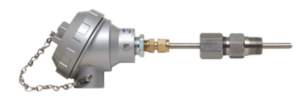RTDs
RTD’s are based on electrical resistance changes through a material that changes in proportion to temperature. The resistance increases with increasing temperature and the most common material is Platinum. Various sheath materials, probe constructions, and lead wire output options are available.
| SERIES | DESCRIPTION | RANGE F.S. |
| ERTD41 | Wirewound copper element, 10 Ohm | -70° C to + 150° C |
| ERTD42 | Wirewound Nickel element, 120 Ohm | -40° C to + 180° C |
| RTD43 | Wirewound Platinum element, 100 Ohm | -250° C to + 600° C |
| MRTD43 | Thin film Platinum element, 100 Ohm | -50° C to + 550° C |
| RTD44 | Wirewound Platinum element, 100 Ohm | -250° C to + 800° C |
| RTD45 | Wirewound Platinum element, 100 Ohm | -250° C to + 600° C |
| RTD86 | Wirewound Platinum element, 200 Ohm | -250° C to + 600° C |
| MRTDF430 | Thin film Platinum element, 1000 Ohm | -50° C to + 550° C |

There are several choices to make in the selection of any Conax Technologies RTD assembly. Firstly we would need to know the sensor element type which would usually be dictated by the required temperature measurement. We would also need to know the tolerance class required and the sensor lead configuration. This can be 2, 3 or 4 wire, or even dual wire configurations. Then we would need to know your choice of sheath material and size, both diameter and length. Termination styles vary from simple wire connections, through cables assemblies, to fitted terminal head boxes. Mounting considerations might also include the use of a pressure sealing gland which Conax Technologies also manufacture.
The choice given all these variations is very large, so please ask for our help in sorting out the best solution for you.
Also available is the MBS range of miniature bearing sensors which can provide a simple and economic way of monitoring the temperature of bearings in industrial rotating equipment.

 D5 Creation
D5 Creation